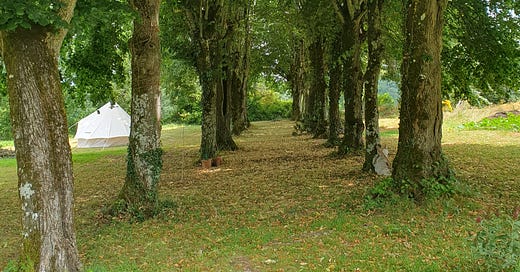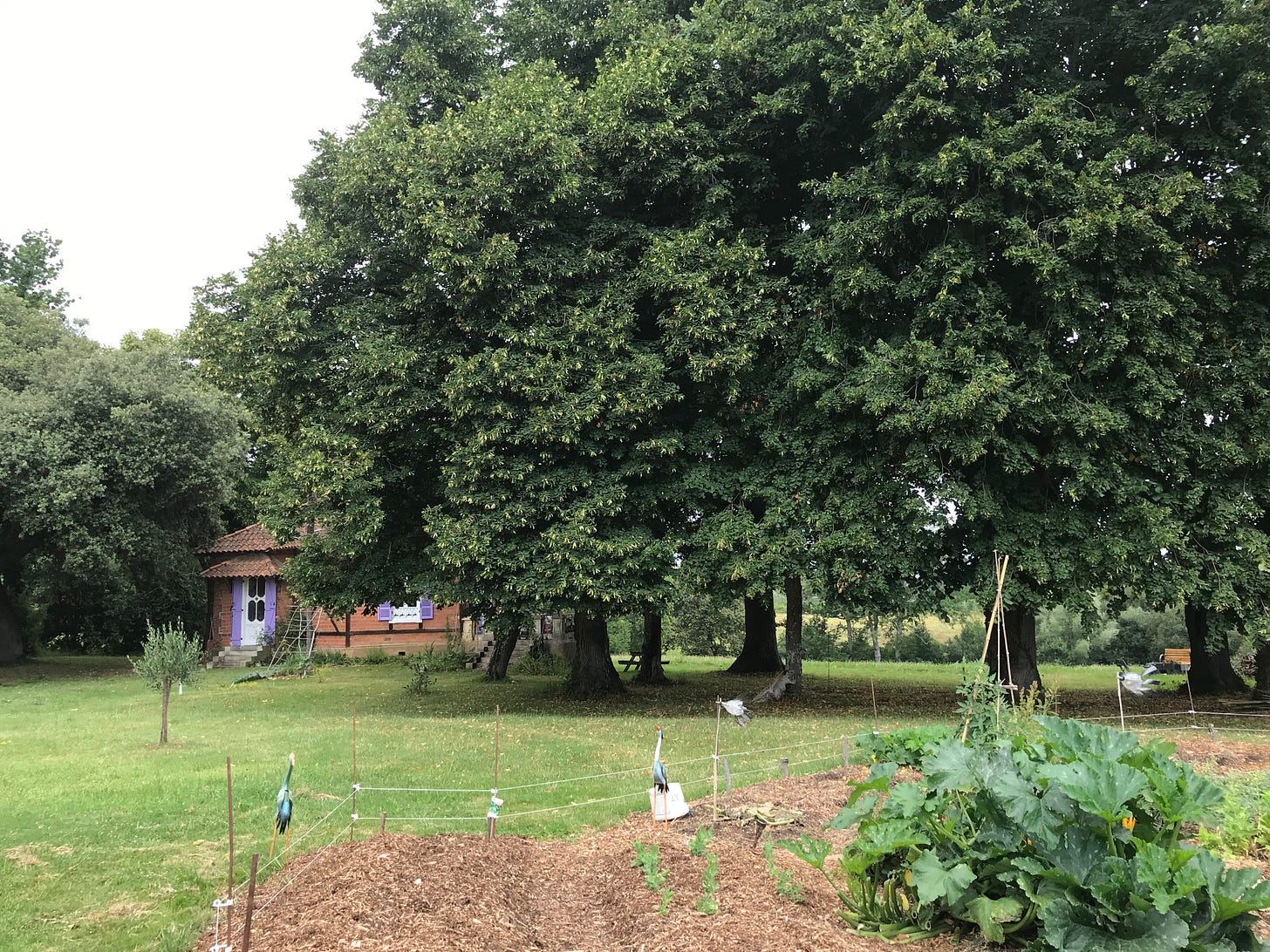On befriending linden trees
I am honoured to have an avenue of linden trees on my land. It was one of the things which drew me here. Indeed my love of avenues of trees, linden, plane or poplar is one of the reasons I love France.
This gorgeous avenue of lindens runs from the Pavillon, where I teach my courses and see shiatsu clients in the summer months, to the edge of our land and is about 100 metres long. It doesn’t actually lead anywhere, and possibly never did. I would love to find out who planted the lindens, but nobody seems to know. I do know that at some point a family from Paris owned the house, which was built in the 17th century, and is of timber and “torchis” construction (torchis is a traditional mortar made from clay and natural fibres: straw, hay, horse hair). This is why there are so many “mares” (large ponds) strewn across the countryside beside old barns and farm buildings: people would dig out the clay and what was left behind became a pond. These are wonderful havens for all sorts of wildlife, but sadly more and more are being filled in these days.
Our pavillon was built in the early 1900’s. It is made of brick, which is fairly unusual in the countryside in this part of France. By contrast, much if not most of traditional Toulouse, the principal city in Occitanie, is largely built of brick.
Originally there were 26 lindens. I have worked this out because the two lines are uneven and there are some gaps. Now there are “only” 20, which are about 12 or so metres high. The ages of these 20 remaining seems to vary, judging by the girth of the trunks. I’m guessing this is because not all the trees grew healthily and some of the originals were replaced. Two large oak trees stand majestically to the sides at each end. These probably grew up unbidden as there are oak trees aplenty around here of all ages and sizes. I am still clearing the land around the linden trees and slowly getting to know them. I want this avenue to become part of how we can explore the magic of Chinese medicine. We might each find a tree and sit with her for a few days, getting to know her place in the line and her connection to the other trees. We can also “dress” the trees and thank them for their presence.
The tree of life
In Chinese medicine, and indeed all healing systems, the tree is a powerful symbol of life. This is why I have chosen the tree as my logo for “La Source”. To survive and thrive, she needs the right balance of sun and rain, a soil which nourishes her and the protection of humans which allow her to age naturally. My trees at some point were unsympathetically pruned, and the fact that 6 of them are no longer with us, reminds me of the responsibility of having trees on my land. The soil here is clay and is very dry, yet the trees thrive. Their roots grow deeply down into the heart of the earth and communicate with other trees.
The linden tree is also known as the lime tree or basswood and belongs to the Tilia genus. In French she is known as the “tilleul”. She is native to the temperate regions of Europe, North America, and Asia and known for her beautiful, heart-shaped leaves, fragrant flowers, and size.
I can attest to the fragrance of the flowers - they are beautiful and attract whole colonies of local honey bees. The tea made from linden flowers is meant to be calming and good to drink at night but happily I sleep so soundly here, I don’t need it. I think I just enjoy the fragrance of the living flowers and the humming of the thousands of bees who are attracted by it.
A sacred tree
The linden tree's beauty and healing properties made her a sacred tree in many cultures from the Baltic to Ancient Greece as well as Egypt and China. Masks made of linden wood have been found in the sarcophagi of the Fayum, an ancient city in Egypt. In Northern China, she was often planted in temples instead of the Bodhi tree, the sacred tree of Buddhism, because her leaf is similar to that of the Bodhi tree, which doesn’t grow in parts of China. There are linden trees in the Forbidden City in Beijing. Unfortunately I wasn’t looking for them when I visited in 1986, otherwise I would have included a photo!
The Catholic Church uses the linden tree to represent the “Sacred Heart” because of its heart-shaped leaf. For the Celts and Germans she was a tree of justice and she is well known in Germany. One of the most famous streets in Berlin is called “Unter den Linden”. This linden tree-lined avenue leads from the centre of Berlin to Potsdam, the country residence of the Prussian kings.
Inspired by the sense of justice and the bond between friends and brothers, Herman Hesse wrote the poignant "The Three Linden Trees", a 1912 fairy tale. He was strongly influenced by the Greek legend of the friendship of Damon and Pythias. Hesse’s tale is the story of 3 brothers who each assume responsibility for a murder which none of them committed, to save one of their brothers. The local prince decides God should decide and orders each brother to plant a linden tree with its roots in the sky and its crown in the ground. Whichever doesn’t thrive will show who the murderer is. Surprisingly, all three survive and their branches intertwine to cover the entire cemetery of the Hospital of the Holy Spirit in Berlin.
During the French Revolution, more than 60,000 linden trees were planted in all the districts of France, and it was consecrated “the tree of liberty”. The Bicentennial of the Revolution was celebrated by replanting linden trees in 10,000 districts.
The linden tree has been associated with Venus, the goddess of love and fertility - perhaps because of her height, the size and shape of her leaves as well as the fragrance of her flowers. In many cultures people would dance under linden trees. Dancing under the trees is perhaps something I can do with my students as a way to connect with the different aspects of the Extraordinary Vessels. For me the Penetrating Vessel represents the mother and her love and nurturing. You might want to connect with my exercise for the Penetrating Vessel on YouTube. This was filmed in my garden in Bristol in 2021. I hope to make some more videos of the Penetrating Vessel among the linden trees. If you like my videos, please subscribe. I also would love to know what other videos you would like to see me post there.
I hope you have enjoyed spending time with me and my musings on linden trees. I’d love your suggestions of how I can befriend and honour my trees and how I can include them in my teachings.









